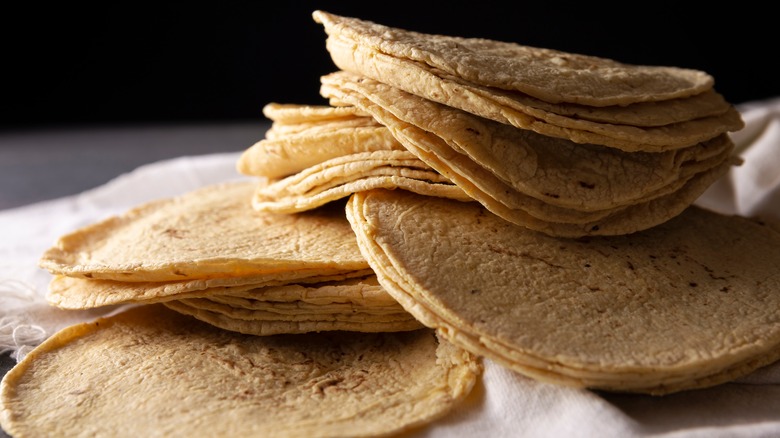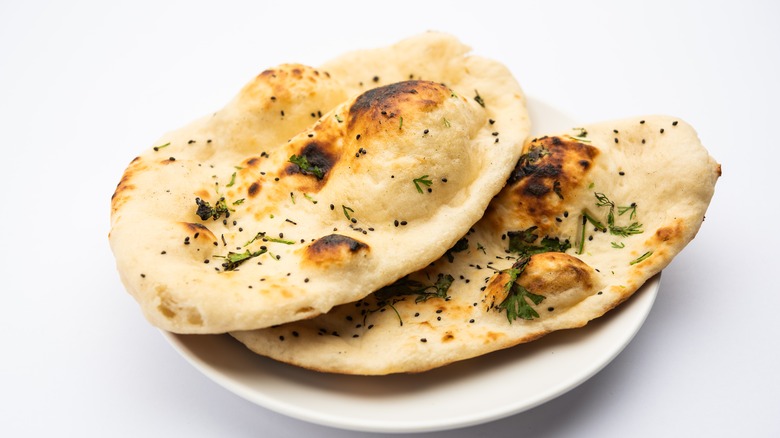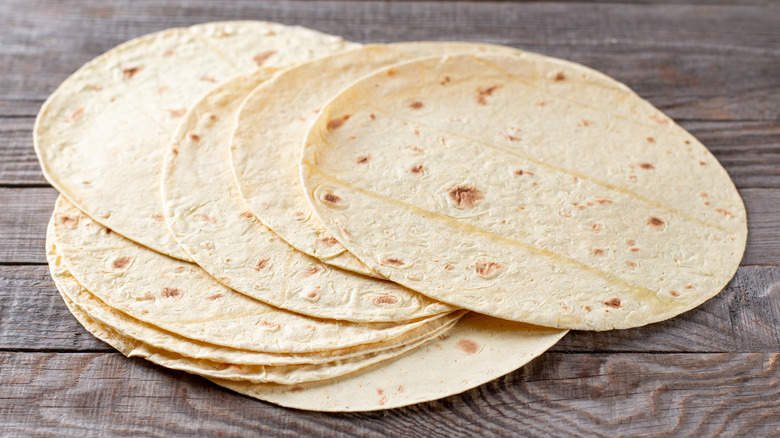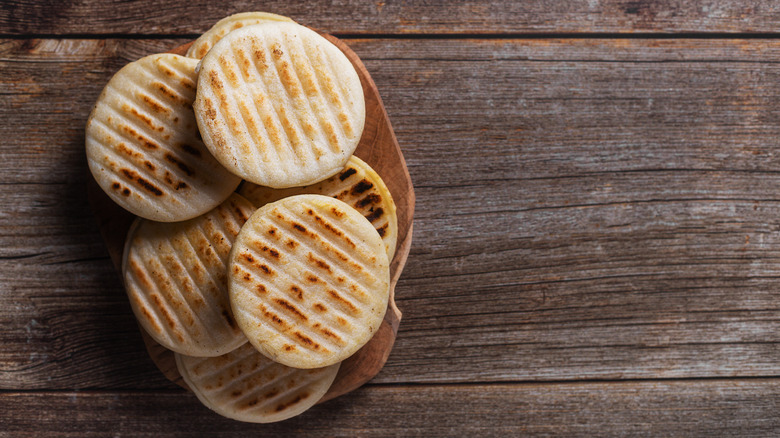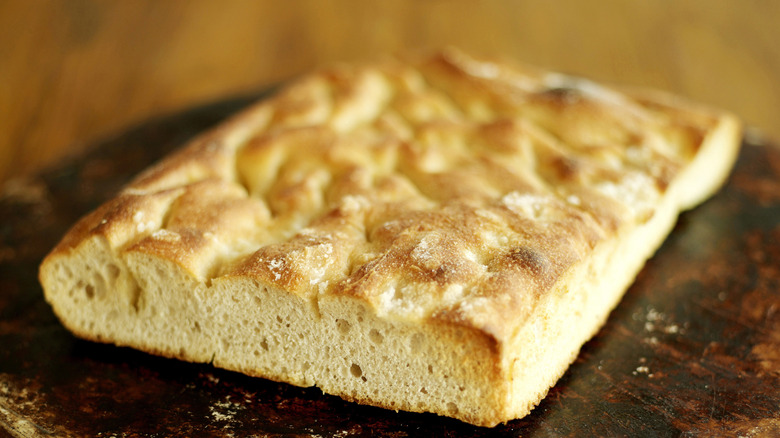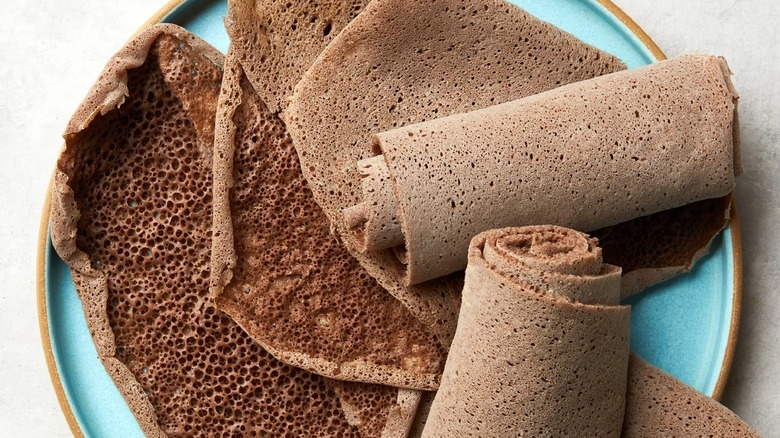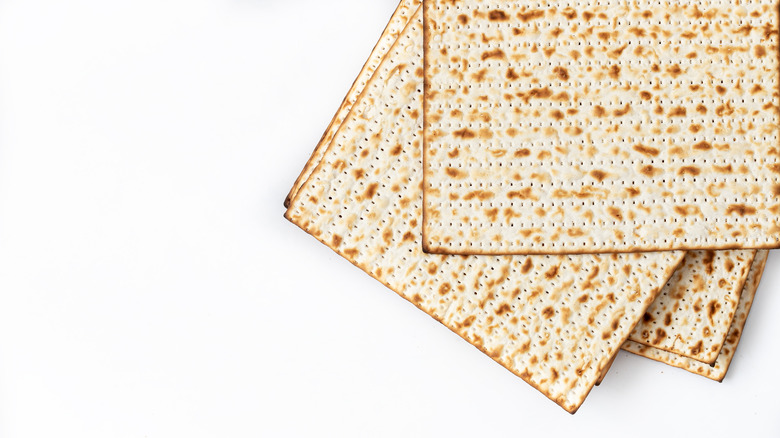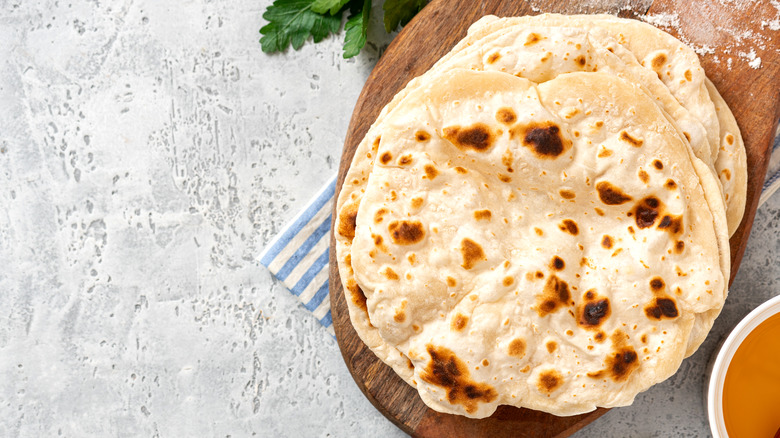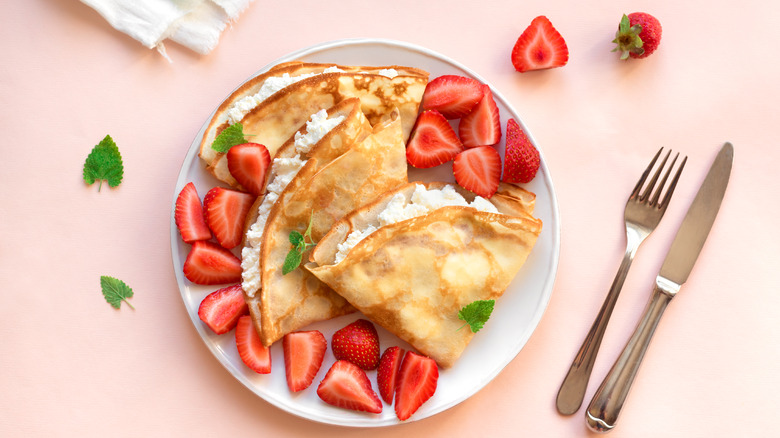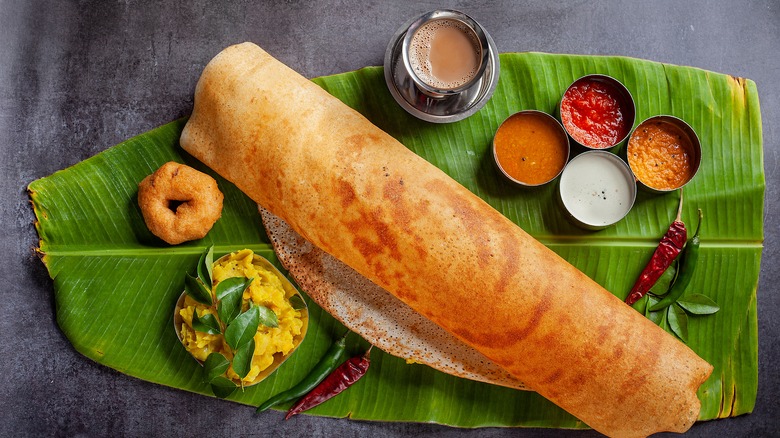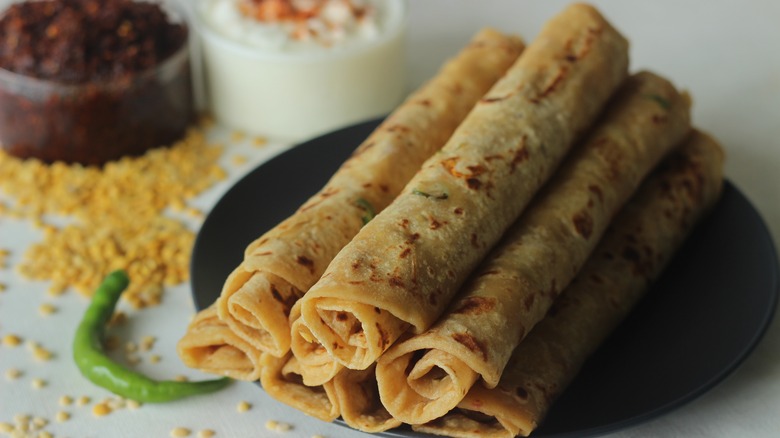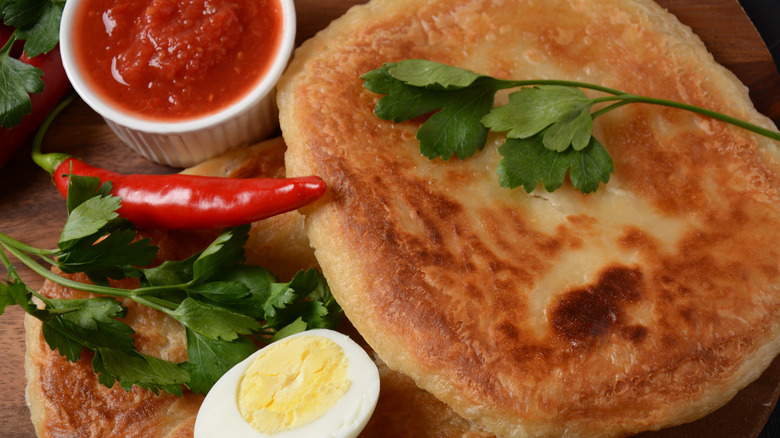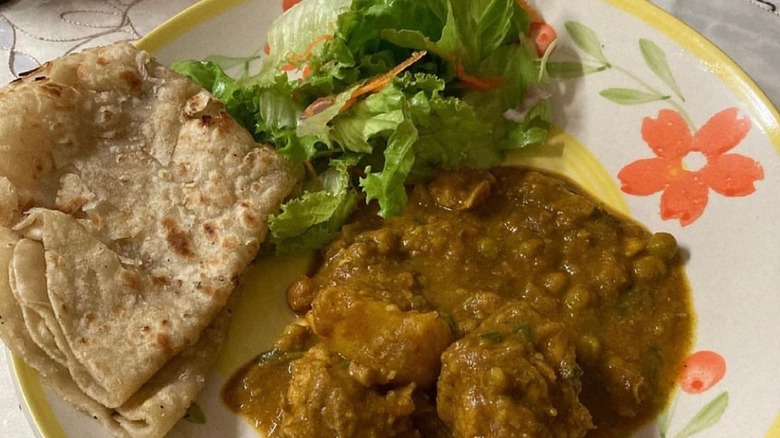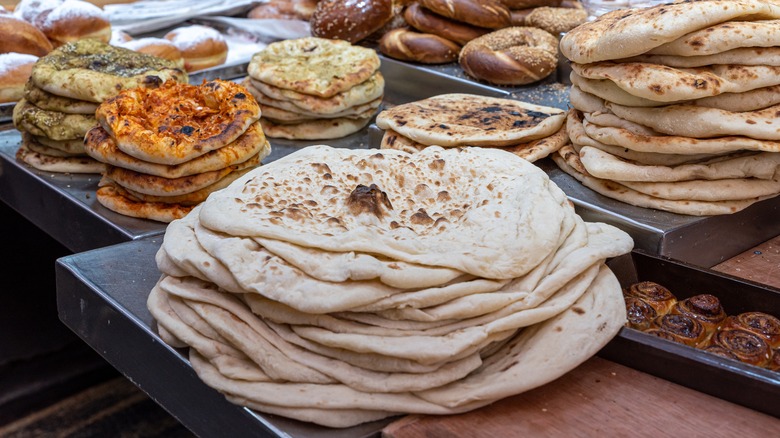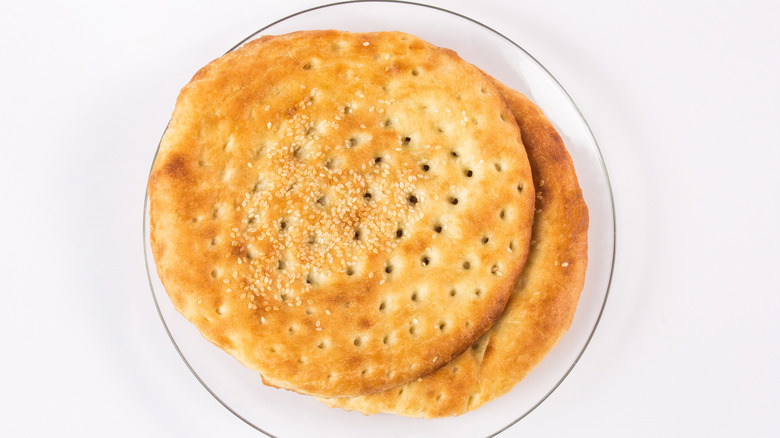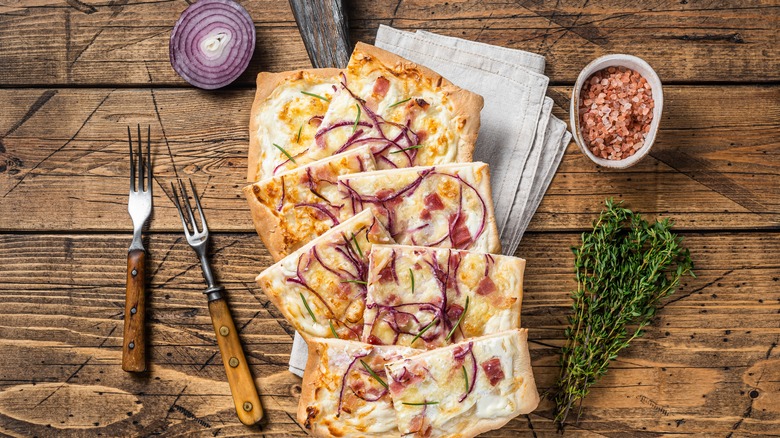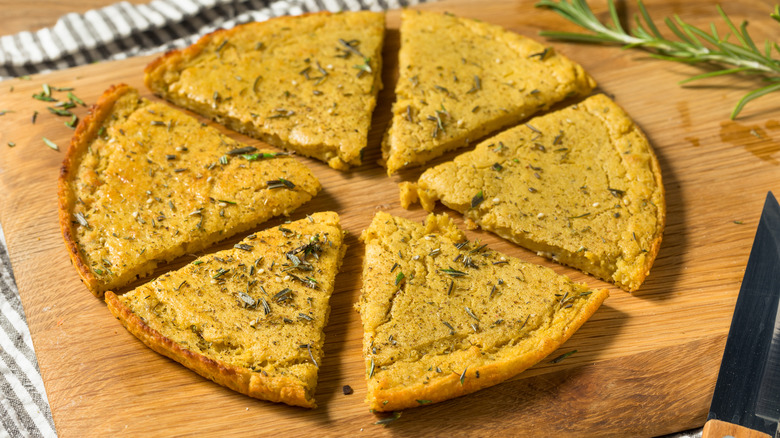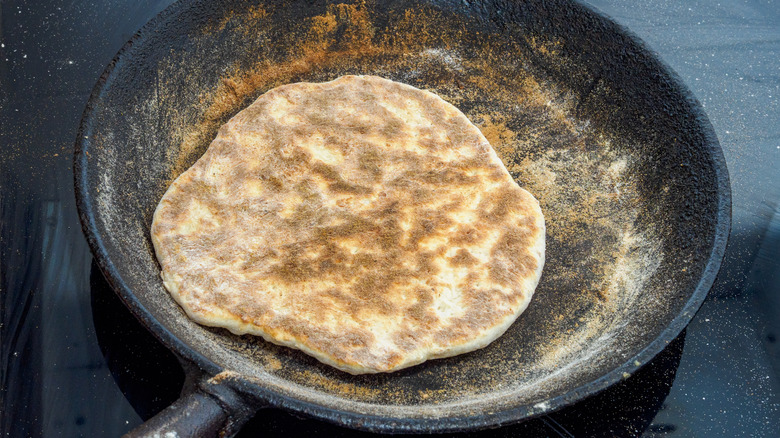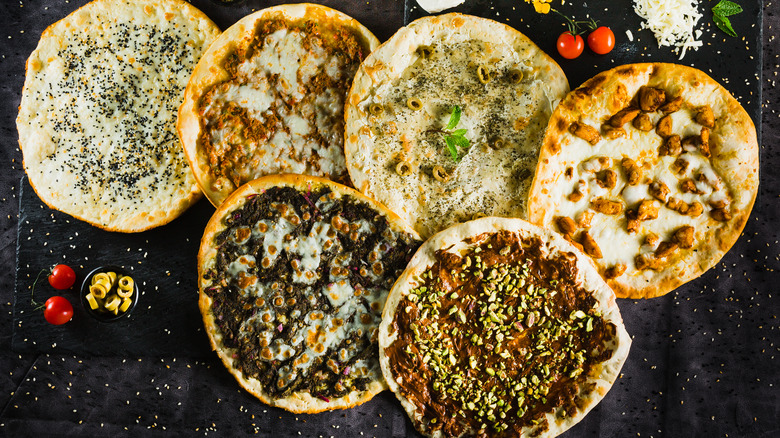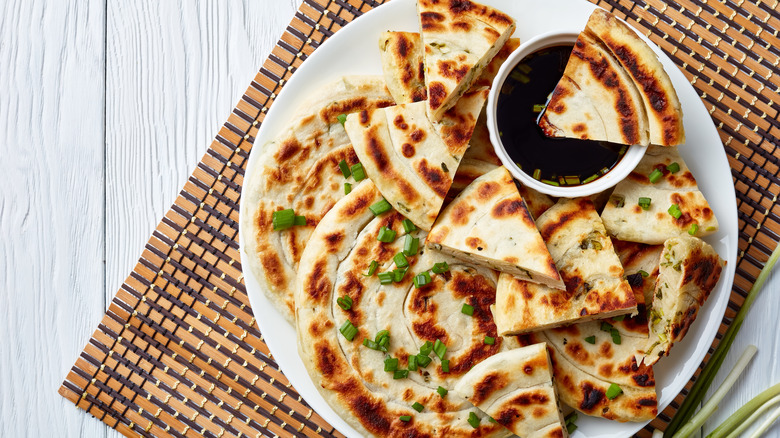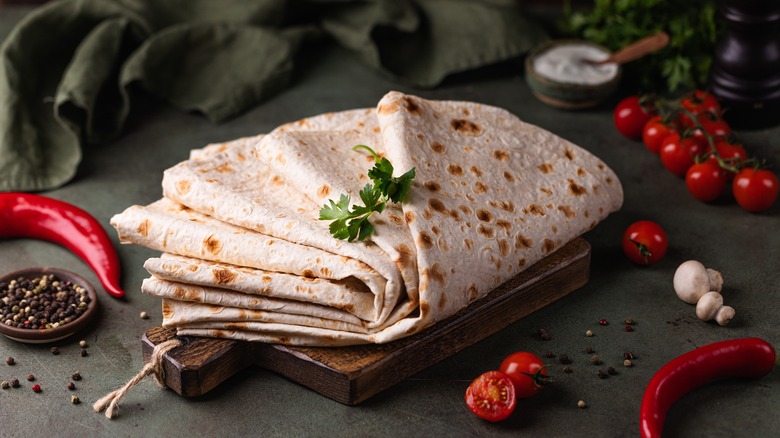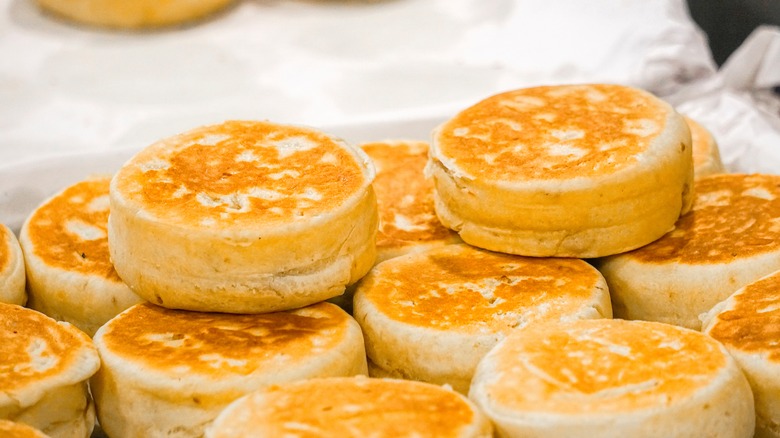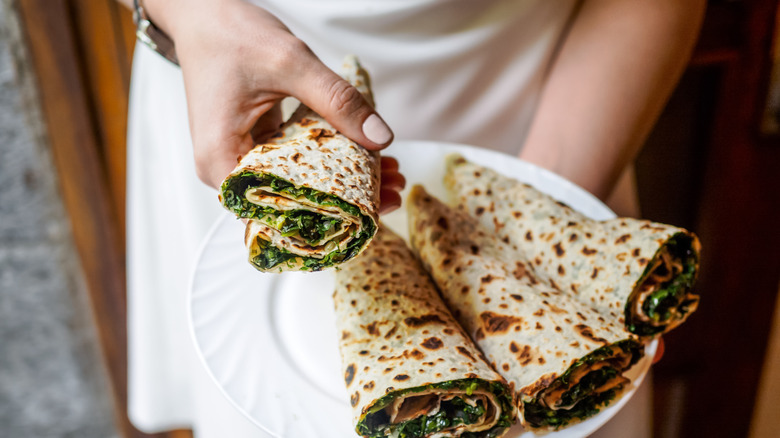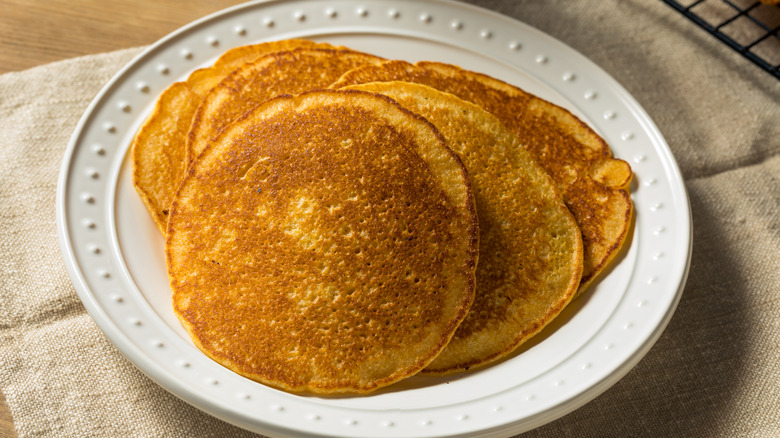23 Types Of Flatbread, Explained
There might not be a single food more influential around the world than bread. While the world's challahs, brioches, and baguettes often take the spotlight, flatbreads have had an arguably more monumental impact on global culture and sustenance since the dawn of time. According to Bakerpedia, the flatbread originated over 6,000 years ago in the Fertile Crescent and has since spread to other continents and regions. The main distinguishing feature between flatbread and other types of bread is its high crumb-to-crust ratio and low-specific volume. This means that flatbreads are — flat. Yet, the two main categories of flatbreads include single-layered (either leavened or unleavened) bread and double-layered, leavened bread.
The main ingredients of a flatbread are flour, water, and salt — thus making the flatbread one of the most versatile ingredients in the kitchen. But despite the perceived simplicity of the flatbread's ingredients, there are apparent differences in how this carb is consumed worldwide. Here are some of the most popular types of flatbread you can find around the world.
Naan
Naan is a wheat flour flatbread that originated in Persia but has become associated with Indian cuisine. This flatbread is plush in texture because the flour is often mixed with yogurt, butter, milk, or eggs. After the ingredients are combined, naan is cooked in a hot clay oven called a tandoor. The heat of the tandoor causes the naan to puff up and develop small bubbles. Although the skillet can also be used to replicate the same blistered appearance of the naan, the tandoor is a much more reliable cooking vessel.
Naan is typically eaten alongside curries to soak up juice, spice, and flavor. It can be seasoned with fresh herbs like cilantro and coated in a layer of ghee (clarified butter).
Tortilla
Tortillas were first believed to be the result of the Mayan civilization living in modern-day Mexico. According to Alto Hartley, one common origin story is that a Mayan peasant offered a corn-based flatbread to a Mayan king. The word "tortilla" is derived from the Spanish word for "little cake" and can be made with corn (maize) or wheat flour. The tortilla's thin shape results from pressing with a metal contraption. After the dough is thinned, it is cooked quickly on both sides in a pan before being served with a myriad of Mexican foods like refried beans or as a vehicle for the beloved taco.
Arepa
Arepas are found in many Central and South American countries, including Venezuela and Columbia. Arepas can be made with precooked corn flour (often sold under the P.A.N. label in the United States), water, and salt. Unlike tortillas, which are very thinly pressed, arepas are formed by hand and are about a ½-inch thick. They also have a smaller diameter of around three to four inches. Arepas can be stuffed with eggs, cheese, or beef or served as a side dish with toppings like salsa, guacamole, or pico de gallo.
Focaccia
Focaccia likely isn't the type of bread you think about when it comes to flatbread, but its high crust-to-crumb ratio technically classifies it as a flatbread. This leavened Italian bread is made with wheat flour, salt, and water. Focaccia is characteristically dimpled to increase its surface area. It can be topped with the standard olive oil and flaked sea salt or made into edible art with rosemary, olives, cherry tomatoes, and onion. It is typically eaten as an appetizer or snack in Italy, but it can also be served alongside hearty Italian pasta or meat dishes as well.
Injera
Injera is an Ethiopian flatbread made with teff flour rather than wheat flour. Teff has an almost oaky flavor with deep organic notes, which makes this flatbread a flavorful addition to an array of spicy Ethiopian food. It is cooked on a skillet, and because the batter is relatively thin, it will form a crepe-like texture. Like other types of flatbread, injera is used as a utensil; its soft, porous texture allows it to easily soak up sauces, stews, and curries.
Matzo
Matzo is commonly thought of as crackers, but this thin Jewish food is technically considered a flatbread. According to Delighted Cooking, matzo is often eaten during Passover, when leavened bread should be avoided. The bland taste of the matzo symbolizes humility, and the unleavened qualities of the bread are symbolic of the Jewish diaspora from Egypt in which bakers did not have time to allow their bread to rise.
There are other foods made with wheat-based matzo, including matzo ball soup. Beyond wheat, matzo can also be made from rye, oats, barley, or spelt. Additionally, you'll find two different forms of matzo: soft matzo and the harder, cracker-like matzo.
Chapati or roti
Roti and chapati are Indian flatbreads that are similar in cooking texture and method and so are used interchangeably in the culinary vernacular. Eat Your World notes that naan, which is cooked in a tandoori, is not the same as a roti or a chapati. Roti and chapati are rolled out much thinner than naan and are cooked on a flat griddle called a tawa. Roti can come in several different types, including the fluffy tandoori roti, extra thin roomali roti, and chickpea-based missi roti seasoned with cumin, turmeric, and red chili powder.
Crepe
There might not be a more romantic flatbread than a crepe. These thin French pancakes are technically classified as flatbread but often include eggs, milk, and either butter or oil. According to the Original Pancake House, crepes were brought to fruition by a 13th-century French housewife who splashed porridge onto a hot skillet. The name came from the Old French word "crespe," meaning "curled," a reference to the sides of the crepe that curl over when the batter is spread over the hot surface.
Buckwheat crepes are typically reserved for savory fillings like meat, cheese, and eggs. White flour crepes ("crêpes de Froment") can be filled with fruit, chocolate, cream, or nuts.
Dosa
Dosas are a common street food in India. These thin, crepe-like pancakes are filled with fragrant warm spices and ingredients like masala, potatoes, and onion. Dosa batter, unlike a flour-based crepe batter, is made with rice and lentils and can be spiced with warm flavors like fenugreek seeds. After the dosa ingredients have soaked overnight, the ingredients are blended into a thin batter that can be spread thinly on a skillet. Then, the batter is cooked for a few minutes before being removed from the pan and rolled with savory fillings. Dosas can be served with chutney or eaten as-is.
Paratha
Paratha is a flatbread endemic to South Asian countries, including Bangladesh, Sri Lanka, Nepal, and Pakistan. Unlike naan or roti, paratha is usually eaten as a stand-alone dish and can be stuffed with cheese, vegetables, or other savory toppings. The word "paratha" is a combination of the Indian word "part," meaning layer, and "atta," meaning flour.
These flatbreads are cooked relatively quickly on a shallow griddle for easy flipping. Our favorite way to prepare paratha is to include warming spices like ginger and garlic, as well as chopped carrots, bell pepper, and green cabbage.
Malawach
Malawach is a Middle Eastern flatbread made as a stand-alone dish or a vessel for scooping hot curries and sauces. The flavor of this bread is delicate and super-rich due to the copious amount of butter used to develop a buttery, layered structure. There are no eggs used to make this flatbread. According to Reboot, malawach was brought to Israel by Yemenite Jews in the 1950s. The bread is usually served with a drizzle of honey or as a savory accompaniment to hard-boiled eggs, tomatoes, and zhug (or schug, a green hot sauce with parsley and cilantro).
Farata
Farata is from the Mauritian Islands, located off the coast of East Africa, and is a version of paratha. This flatbread is made with three simple ingredients cooked in a tawa: water, flour, and oil. The farata is usually served with a Mauritian curry, though it may include other ingredients or fillings. Finding the Universe notes that farata is sold by street vendors across the country. In a restaurant, farata is served alongside dholl puri — a Mauritian pancake made with ground yellow split peas — rather than rice.
Pita
If you have dined at a Mediterranean restaurant, you have likely enjoyed a serving of pita along with your meal. Most types of pita have a pocket for stuffing savory spreads like hummus and baba ganoush, but the Greek-style pita does not.
Whatever global region you're sourcing your pita from, the bread likely has a pliable quality to it, making it ideal for stuffing and rolling. And since the pita gets its flavor from whatever it is paired with, you can expect that eating pita raw is a relatively bland experience. The dough is made with wheat flour, water, neutral oil, yeast for leavening, and a bit of salt for flavor.
Sheermal
Sheermal is saffron-seasoned flatbread found in Middle Eastern countries like Iran and Pakistan, but it's also found in Northern India (via Delighted Cooking). Unlike roti, Sheermal is made with milk as well as the typical leavening agents of yeast and base of all-purpose flour. Sheermal roughly translates to "milk bread" and is much richer than its drier Indian flatbread counterparts. Sheermal is served warm with other Irani and Pakistani proteins like kebabs and soups, although it was historically reserved for royalty and special occasions in the region.
Flammkuchen
Flammkuchen is a German flatbread that is often treated like a base for pizza. This flatbread originated in the Alsace region of France, which straddles the German border (via Culture Trip). It was first believed that Germans who made the flatbread were focused on making food that could feed the working population in the area. One day, a baker schmeared a thin piece of dough with crème fraîche, sliced onions, and bacon, then baked it in a wood-fired oven. And thus, the flammkuchen was born.
Typically, the base of the pizza-like food is made with rye flour for a bit more texture. While other topping combinations are used, the original crème fraîche recipe remains the most popular rendition of this flatbread.
Socca
Socca is a French street food that resembles both a pancake and a flatbread. This wonderful carb is made with chickpea flour, olive oil, and water. Once the ingredients are combined, the batter is poured into an awaiting shallow pan and baked until crispy. After it is finished baking, the socca is cut into wedges and seasoned with cracked black pepper. The Italian farinata is very similar and made with the same base ingredients but with the addition of sea salt and rosemary.
Tunnbröd
Tunnbröd, otherwise known as polar bread, is of the most common flatbreads in Sweden. iFoodTV notes that the name of this flatbread translates to "thin bread" in Swedish and usually includes a blend of flour like rye and wheat. Tunnbröd is leavened with yeast and can vary in size and shape due to the rolling pin used to flatten the dough.
In Sweden, tunnbröd can be used to make tunnbrödsrulle (also called the tunnbröd roll): a fast-food treat of mashed potatoes and a hot dog wrapped in flatbread. And yet, one of the earliest (and still most beloved) ways to eat tunnbröd is with roasted or fermented herring.
Manakeesh
Manakeesh is a popular flatbread in the Levantine region of the Middle East. The root of the singular version of manakeesh (mankosheh) translates to "that which is decorated with colors, writing or that which is engraved" (via Chef in Disguise). In the Levant, manakeesh is decorated with one or two toppings, including za'atar, labneh, or eggs. Chef in Disguise notes that manakeesh is often eaten as a breakfast food in Jordan, Syria, and nearby countries and has been modernized to include toppings like Nutella, banana, cheese, and meat.
The manakeesh is a unique bread for another important reason beyond its toppings. The bread is cooked in a taboon oven — a Palestinian cooking vessel made from a specific type of clay and hay. Taboon ovens are built outside the home and are filled with hot rocks, which results in the dimpled appearance of the manakeesh.
Scallion pancake
If you've been to an Asian restaurant, you have probably seen scallion pancakes on the appetizer menu. These pancakes can either be thin and crispy or puffy and naan-like in texture. There are no leavening agents in this flatbread — just wheat flour, scallions, salt, water, and a bit of oil to crisp up the sides. While schmaltz (rendered chicken fat) and vegetable oils are often used to make these pancakes, the recipe can be easily modified to plant-based or low-oil. Scallion pancakes are commonly served with a soy or hoisin dipping sauce or can be eaten as an accompaniment to other Asian-inspired dishes.
Lavash
Like pita, lavash is a flatbread that originated around the Middle East. This leavened or unleavened bread was originally baked in a subterranean clay oven called a tonir (via Organic Flatbread) but has since been modernized to cook in an oven or on a griddle.
In Turkey, lavash is served with kebabs to make doner kebab wraps or served alongside other Turkish entrées. The main difference between lavash and its older cousin, the pita, is where each was first made; lavash was created closer to the Black Sea and Caspian Sea than the pita. Lavash can also be prepared leavened or unleavened, while pita is always a leavened bread.
Shaobing
Shaobing is a baked, unleavened flatbread found in Northern China. These small, layered, and disc-shaped flatbreads are usually topped with sesame seeds and eaten for breakfast (via Wise Geek). Shaobing is often sold by street vendors in China and can be made with layers of sweet or savory filling. Red bean paste, mung beans, tofu, and egg are common savory fillings, while the more plain, unfilled rolls are served alongside eggs and breakfast meats. In the north, diners will pair shaobing with soup or as a side, while the southerners tend to stick to the sweet breakfast shaobing and soy milk.
Zhingyalov khat
According to Food Perestroika, zhingyalov khats are herb-forward stuffed flatbreads found in Armenia. Depending on the pronunciation and region, the dish can also be translated as zhengyalov hac or jingalov hats.
Zhingyalov khats are made with between seven and nine types of fresh herbs (like leeks, scallions, and parsley) and stuffed into a lavash-style flatbread. The dough is rolled out onto a flat surface, stuffed copiously with herbs, and folded back over before being griddled. Unlike lavash, Food Perestroika notes that the zhingyalov khats have to be cooked for much longer. Zhingyalov khats are often doused in butter or eaten alongside Armenian kebabs.
Johnnycake
Johnnycakes are an often-forgotten flatbread in America. These thin, cornmeal flatbreads are found in both New England and the South. Traditional preparation of the johnnycake just stuck to cornmeal, water, and salt, but modern preparations have since included fats, egg, sugar, and wheat flour. The johnnycakes are cooked on a griddle like a pancake before being served with maple syrup or fresh fruit.
Johnnycakes were originally created by Native Americans who grew corn aplenty. The name "johnnycake" was most likely a product of both mispronunciation and time. It is believed that the first johnnycakes were called Shawnee cakes or derived from "janiken" — the American Indian word for "corn cake." The low moisture and portability of this flatbread were also instrumental in the name "journey cake," which may have morphed into the common vernacular of johnnycake.
